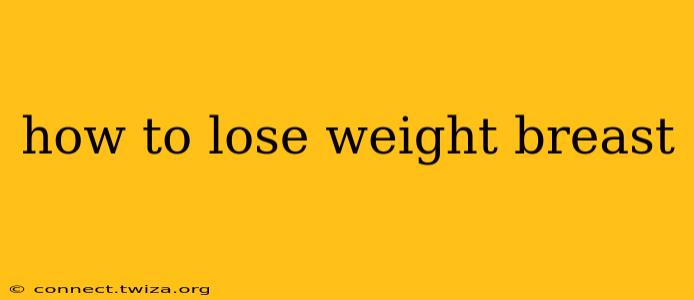Losing weight in a specific area of your body, like your breasts, is unfortunately not possible through targeted exercises or diets. Spot reduction is a myth. Weight loss happens throughout the entire body, and the rate at which fat is lost in different areas is determined by genetics and individual body composition. However, you can lose overall body fat, which will naturally lead to a reduction in breast size if you have excess fat in that area. This guide outlines a holistic approach to achieving this.
What Causes Breast Fat?
Before diving into solutions, let's understand the factors contributing to breast fat. While genetics play a significant role in breast size and shape, several lifestyle factors can influence the amount of fat stored in the breast tissue:
- Overall Body Fat Percentage: High overall body fat leads to fat accumulation in various areas, including the breasts.
- Hormonal Changes: Fluctuations in estrogen levels, particularly during puberty, pregnancy, and menopause, can impact breast size and fat distribution.
- Diet: A diet high in processed foods, sugary drinks, and unhealthy fats contributes to weight gain overall, including in the breast area.
- Lack of Exercise: Insufficient physical activity slows down metabolism and can lead to increased fat storage.
Can You Reduce Breast Size Through Exercise?
No, not directly. You cannot spot-reduce fat from your breasts. However, regular exercise is crucial for overall weight loss and improving body composition. A combination of cardio and strength training is most effective:
- Cardio: Activities like running, swimming, cycling, and brisk walking help burn calories and reduce overall body fat.
- Strength Training: Building muscle mass increases your metabolism, leading to more efficient calorie burning, even at rest. Focus on exercises that work large muscle groups, such as squats, lunges, push-ups, and rows.
What is the Best Diet for Breast Fat Loss?
There's no magic diet to target breast fat. The key is to follow a balanced, calorie-controlled diet that supports overall weight loss. This involves:
- Calorie Deficit: Consuming fewer calories than you burn is essential for weight loss. Consult a nutritionist or use a calorie tracking app to determine your daily calorie needs.
- Healthy Foods: Focus on whole, unprocessed foods like fruits, vegetables, lean proteins, and whole grains. Limit processed foods, sugary drinks, and unhealthy fats.
- Hydration: Drink plenty of water throughout the day. Water helps boost metabolism and can contribute to feelings of fullness.
Does Reducing Breast Size Affect Breastfeeding?
It depends. Reducing breast size through weight loss shouldn't directly impact your ability to breastfeed, provided you achieve weight loss in a healthy manner. However, significant weight loss can sometimes affect milk production, although this is not always the case. If you're concerned about breastfeeding, consult with a lactation consultant or your healthcare provider.
How Long Does it Take to Lose Weight in the Breasts?
The time it takes to lose weight in your breast area depends on several factors, including your starting weight, diet, exercise routine, and genetics. It’s crucial to approach weight loss gradually and sustainably. Aim for a healthy rate of 1-2 pounds per week. Be patient and consistent, and you will see results over time.
Can Surgery Reduce Breast Size?
Surgical breast reduction is an option for those who desire a significant reduction in breast size for cosmetic or health reasons. However, this is a major surgical procedure with potential risks and complications. It's crucial to discuss this option with a qualified plastic surgeon to determine if it’s the right choice for you.
Remember, sustainable and healthy weight loss takes time and effort. Consult your doctor or a registered dietitian before making any significant changes to your diet or exercise routine, especially if you have any underlying health conditions. Focus on a balanced approach to health and well-being rather than targeting a specific body part.
